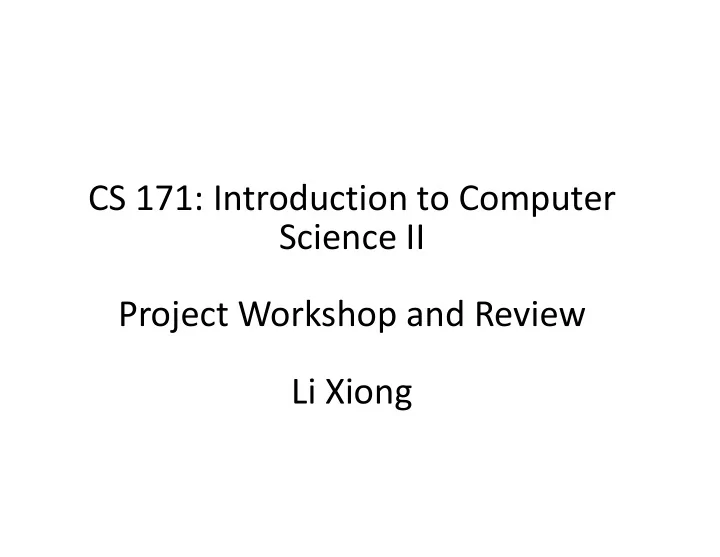

CS 171: Introduction to Computer Science II Project Workshop and Review Li Xiong
Today � Project workshop � Final review � Course evaluation
Project Workshop � FaceSpace � Alex Fields and Andres Celis � MapQuest � Kenty Wang � Kenty Wang � Jennifer Lin � Xiaobo Sun
Project Workshop � Project design – class design, algorithm design, data structures, GUI design � Project development – development, debugging, integration � Project experience – interesting and challenging � Project experience – interesting and challenging aspects, lessons learned � Application Demo – program features, desired features/remaining work
Review � Data structures � Algorithms � When to use what
Summary of Data Structures � General purpose data structures � Arrays � Linked lists � Trees � Hash tables � Hash tables � Specialized data structures � Stacks � Queues, priority queues � Graphs
Summary of Algorithms � Associated with each data structure � Insert � Delete � Search � Traversal � Graph algorithms � Sorting � Bubble, insertion, selection � Merge sort � Quick sort
Algorithm Analysis � Big-O notation � Common functions � constant, logarithm, linear, quadratic, polynomial, exponential, factorial in increasing order of growth � Cost analysis � Cost analysis � Direct methods � Recursive relations (specially useful for recursive algorithms)
Programming/Problem Solving Techniques � Recursion � Divide and conquer � Backtracking � Dynamic programming – memoization
When to Use What? � General-purpose data structures � Arrays (unordered) � Ordered arrays � Linked list (unordered) � Linked list (unordered) � Ordered Linked list � Binary search tree (unbalanced) � Self-balancing binary tree � Hash tables
When to Use What? � Comparison of General Purpose Structures:
When to Use What � Speed � Array and Linked Lists < Trees < Hash Table for large amount of data � Catch � Trees � Trees � Binary search tree may be imbalanced � Balanced trees are complex � Hash tables � A good hash function may be difficult to achieve � Hard to expand (dynamic resizing of the array) � Performance degrade when table is too full � Can’t store data in sorted order
Specialized data structures � Stacks � Push, pop � Queues � Insert, remove � Priority queues � Insert, removeMin/removeMax � Binary heaps � Graphs � List of edges, adjacency matrix, adjacency list � BFS and DFS traversal algorithms � Shortest paths for unweighted graphs (BFS) � Shortest path for weighted graphs (Dijkstra, A*)
Final Exam � May 7, 4:30 – 7pm, W303 � Exam format and difficulty level are similar to mid-term, quizzes, practice exam � It is accumulative: 1/3 before midterm, 2/3 after midterm � Brief review guide and practice exam are posted
Parting thoughts � You have learned a great deal! � Beginning at the end � Thank you for a great semester and would love to hear from you or see you in a future class!
Recommend
More recommend